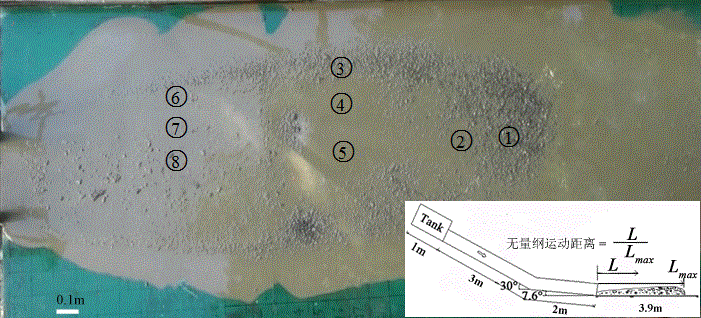The deposition of debris flow and its morphology is essentially important for hazards mapping and risk management. However, the mechanisms of debris flow deposition are still poorly understood due to the complicated solid-fluid two-phase flows. Prof. ZHOU Gongdan and his research group from the Institute of Mountain Hazards and Environment, Chinese Academy of Sciences, considered the internal and external influence factors and achieved some key progress.
The research team investigated the internal (solid phase: particle gradation and fluid phase: water content) and the external (slope of the terrain) factors on the deposition of debris flow (e.g., aspect ratio, accumulation area, deposition thickness, and accumulation volume, etc.), respectively. Experimental results illustrate a positive correlation between the water content and the maximum runout distance, deposit area, deposit volume, and runout-width ratio; whereas a negative correlation between the water content and the maximum deposit height can be observed. Moreover, an increase of fines content in debris flow can reduce the runout distance, but this phenomenon is quite limited for the debris flows with a high water content (e.g., W = 28.5%). It is noted that the channel topography with a smooth sloping transition for debris flows can promote the runout distance. It is further demonstrated that the debris flow deposition is closely related to the particle sorting/segregation: debris flows with high water contents show obvious particle sorting while the viscous debris flows with high solid volume fractions are difficult to segregate. A critical value of the solid volume fraction Cs = 0.52 for debris flow segregation during the deposition exists: the solid fraction of debris flows is less than 0.5, the mean particle size of the deposited material gradually increased from the tail to the front, towards the edges of the flow, and vertically towards the free surface. For debris flows with high solid fraction (Cs > 0.52 in this study), pore fluid viscous shearing plays an important role in reducing the segregation of solids.
The research works are financial supported by the National Natural Science Foundation of China, the Youth Innovation Promotion Association, Chinese Academy of Sciences (CAS), the CAS “Light of West China” Program, and the Research Grants Council of the Government of Hong Kong SAR, China. The results have been published online in Landslides.

Figure1. Flow regimes in debris-flow deposit. (a) Bagnold number versus solid fraction; (b) Savage number versus solid fraction; and (c) Friction number versus solid fraction (Image by ZHOU Gongdan).


Figure 2. Deposition and samples sites (a) in the fan of experimental debris flow with W = 40.0% (Cs = 0.40); (b) The mean particle size (d50) of each sample (Image by ZHOU Gongdan).


Figure 3. Deposition and samples sites (a) in the fan of experimental debris flow with W = 22.0% (Cs = 0.52); (b) The mean particle size (d50) of each sample (Image by ZHOU Gongdan).
Contact:
Prof. ZHOU Gongdan
Institute of Mountain Hazards and Environment, Chinese Academy of Sciences
Chengdu, Sichuan, 610041, China
Tel: 86-13980660182
E-mail: gordon@imde.ac.cn
